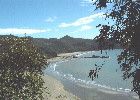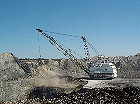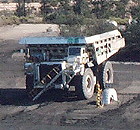Places visited in this part of the trip:
Cape Hillsborough
Clermont and Blair Athol Mine
Alpha
Barcaldine and Aramac, an area full of history
Ilfracombe
Longreach
Note: Many things have changed since we took this trip, so some statements are out of date. For example, mobile phone service (Telstra’s CDMA, now replaced by NextG) has been available for many years in most or all of the towns visited, though it wasn’t when we visited. (GSM is also available in some towns.) Some items mentioned as planned or in development were completed several years ago. We’ve updated many of the links to other information sources, but we haven’t (yet) attempted to add notes on all the other changes.
I’m writing this in Kynuna, Queensland, two weeks into our first major trip in the motorhome. We’ve seen and done so many interesting things, it seems like we’ve been gone for longer.
Never heard of Kynuna? Neither had we, until we read up on this part of the country. Read on… I’ll get back to it soon.
We have been working on organising and uploading the photos. I’ll amend this page when the albums are available.
Cape Hillsborough

 We started out from Airlie Beach and drove south towards Mackay, stopping the first night at Cape Hillsborough National Park. We had a choice of two camping areas, and chose the nature resort, which had beachfront cabins and motel units, van and camp sites. We stayed three nights, taking several interesting walks, including a boardwalk through the mangroves, a nature trail through various woodlands (with a view of an Aboriginal fish trap), and a walk at low tide across an exposed causeway to a nearby island.
We started out from Airlie Beach and drove south towards Mackay, stopping the first night at Cape Hillsborough National Park. We had a choice of two camping areas, and chose the nature resort, which had beachfront cabins and motel units, van and camp sites. We stayed three nights, taking several interesting walks, including a boardwalk through the mangroves, a nature trail through various woodlands (with a view of an Aboriginal fish trap), and a walk at low tide across an exposed causeway to a nearby island.
The caravan park was somewhat primitive to our tastes, but is in a wonderful location, and we had (just) sufficient space to park our large motorhome. Facilities were fine, and the bar and restaurant wonderful. We’d have liked a little more gravel and rock on the roads and paths, as the mud and dust were a problem. You can contact the internet via the caravan park office, under some cirumstances (not attempted). We could pick up a mobile phone signal from the high ground, though not from the resort.
Contact information: Cape Hillsborough Nature Resort, MS 895, Mackay Qld 4740, phone 07 4959 0152, http://www.capehillsboroughresort.com.au
Clermont and Blair Athol Mine
From Cape Hillsborough we drove back to the main highway and then did a bit of zig-zagging to bypass Mackay and get onto the Peak Downs Highway heading southwest to Clermont. There’s not much to do or see on the way, without diverting from the road. The town of Nebo had a 24 hour service station and restaurant, but we didn’t spot any showers. The Shell Roadhouse at the Moranbah turnoff had 24 hour food, space for caravans and trucks to park behind, and showers.
 Clermont is in a major mining area, mostly coal but other materials as well. We stayed two nights at the Clermont Caravan Park, which had on site air conditioned cabins and vans as well as van sites. Well tended lawns and flush concrete slabs and made roads eliminated contact with mud. The showers were well designed so the water didn’t get on your clothes and dressing area, and there were three separate ablution blocks and laundries. We learned it was originally designed by Blair Athol Coal mine for its workers. Contact information for the caravan park: Haig Street, Clermont Qld 4721, ph.(07)49831987.
Clermont is in a major mining area, mostly coal but other materials as well. We stayed two nights at the Clermont Caravan Park, which had on site air conditioned cabins and vans as well as van sites. Well tended lawns and flush concrete slabs and made roads eliminated contact with mud. The showers were well designed so the water didn’t get on your clothes and dressing area, and there were three separate ablution blocks and laundries. We learned it was originally designed by Blair Athol Coal mine for its workers. Contact information for the caravan park: Haig Street, Clermont Qld 4721, ph.(07)49831987.
A few enterprises operated out of the caravan park, like the gold fossicking operated by Graham Pepper, who hired detectors and gave instructions. We found we could have connected to the internet at the nearby town library. Also, the caravan park offered use of their fax line if we needed it.

 The very interesting tour of the Blair Athol Mine was free. It included a stop at the local historical museum, also very interesting with its collections of old household appliances, and other memorabilia. They had salvaged several large buildings from the town, including a complete boardroom from an early coal mine, a complete hospital, a fire engine, and mining and other machinery from early days, much of it in fine condition. It was wonderfully entertaining.
The very interesting tour of the Blair Athol Mine was free. It included a stop at the local historical museum, also very interesting with its collections of old household appliances, and other memorabilia. They had salvaged several large buildings from the town, including a complete boardroom from an early coal mine, a complete hospital, a fire engine, and mining and other machinery from early days, much of it in fine condition. It was wonderfully entertaining.
Alpha
We skipped the gemfields this trip, because the annual Gemfest was on that weekend, and all the campgrounds and motels were full. We could have camped in a field, but we’re not keen on crowds, so we decided to come back another time. The towns have names like Emerald, Sapphire, and Rubyvale. If you’d like to find out about the gemfields, look in issue 14 of this newsletter for some Web sites.

 Instead, we drove the back road from Clermont to Alpha, 170 km of crushed gravel, mostly in quite good condition. Alpha is located on the main Capricorn Highway that runs from Rockhampton west to Longreach. Alpha is small but boasts several interesting murals painted on various buildings, including the public toilets. We wandered around a bit, but didn’t stay long. The town did have a caravan park.
Instead, we drove the back road from Clermont to Alpha, 170 km of crushed gravel, mostly in quite good condition. Alpha is located on the main Capricorn Highway that runs from Rockhampton west to Longreach. Alpha is small but boasts several interesting murals painted on various buildings, including the public toilets. We wandered around a bit, but didn’t stay long. The town did have a caravan park.
Barcaldine and Aramac, an area full of history
In Barcaldine (pronouned Bar-CALL-din), population around 2,000, we stayed at the Homestead Caravan Park, a very welcoming place. The owners made free billy tea and damper with Golden Syrup each evening, and also put on a sausage sizzle. Contact them at Blackall Road, Barcaldine Qld 4725, phone/fax (07) 4651-1308.

 Barcaldine was established in 1886 with the arrival of the railway. All sorts of major historical events took place here, including the founding of the precursors to two of Australia’s major political parties. The formation of the Graziers Association in 1889 led to the formation of the National Party, and the shearers’ strike in 1891 led to the formation of the Workers Party, which later became the Australian Labor Party.
Barcaldine was established in 1886 with the arrival of the railway. All sorts of major historical events took place here, including the founding of the precursors to two of Australia’s major political parties. The formation of the Graziers Association in 1889 led to the formation of the National Party, and the shearers’ strike in 1891 led to the formation of the Workers Party, which later became the Australian Labor Party.
In addition to the six pubs on the town’s main street (Oak Street), a historical museum, and various other sites, a major tourist attraction is the Australian Workers Heritage Centre, a large and impressive site with several buildings containing displays explaining the history of Australian workers and of the labour movement, including a railway station, school, power station, police, fire, and main roads. They are working on a major exhibit on women at work.
http://www.australianworkersheritagecentre.com.au/
We found two places with Internet connections, including the information centre, but we didn’t bother to pick up our e-mail. There’s definitely no mobile phone access in town!

 Tom Lockie of Artesian Country Tours was a very audible presence around the camp fire at the caravan park each evening, telling stories and jokes, and obviously very familiar with the history of the entire area. We were so impressed that we stayed in town an extra three days just to go on his one-day tour to Aramac and nearby areas. We’ll be writing that tour up in more detail for the website, so we’ll just say here that we were very impressed and recommend it highly. Contact Tom Lockie at PO Box 232, Barcaldine Qld 4725, ph. (07) 46512211, fax (07) 46512499.
Tom Lockie of Artesian Country Tours was a very audible presence around the camp fire at the caravan park each evening, telling stories and jokes, and obviously very familiar with the history of the entire area. We were so impressed that we stayed in town an extra three days just to go on his one-day tour to Aramac and nearby areas. We’ll be writing that tour up in more detail for the website, so we’ll just say here that we were very impressed and recommend it highly. Contact Tom Lockie at PO Box 232, Barcaldine Qld 4725, ph. (07) 46512211, fax (07) 46512499.
Aramac was the first town settled in the area. At one stage in the 1800’s, some hugely impressive volume of wool was being shipped out of the area on huge horse- or bullock-drawn wagons. Tom Lockie said that Aramac was then as well known as Sydney, and people around the world knew it was in Australia — even if they had no idea where Australia was!

 Before leaving Barcaldine, we went to the railway station at 8:30 am to see the twice-weekly train, the Spirit of the Outback, come in from Longreach on its way to Rockhampton and Brisbane. Tom Lockie was there, seeing off some of the people from his tour, and encouraged us to walk through several cars of the train to see the comfortable facilities. We were favourably impressed.
Before leaving Barcaldine, we went to the railway station at 8:30 am to see the twice-weekly train, the Spirit of the Outback, come in from Longreach on its way to Rockhampton and Brisbane. Tom Lockie was there, seeing off some of the people from his tour, and encouraged us to walk through several cars of the train to see the comfortable facilities. We were favourably impressed.
Ilfracombe
 We stopped about 70 km up the road at Ilfracombe, originally called Wellshot, where for the first time since we left the coast, we could get a mobile phone signal. There were a number of sheltered picnic tables in the park alongside the road, and lots of public toilets, some with wheelchair access. The 1911 Post Office was also the library, the toy library and the local internet access point.
We stopped about 70 km up the road at Ilfracombe, originally called Wellshot, where for the first time since we left the coast, we could get a mobile phone signal. There were a number of sheltered picnic tables in the park alongside the road, and lots of public toilets, some with wheelchair access. The 1911 Post Office was also the library, the toy library and the local internet access point.
The tourist attractions included the 1898 Wellshot Pub, which has a daily 40 minute stockman act, hotel accommodation, and the caravan park. The machinery and heritage museum has a long string of heavy machinery stretching further than the town along the side of the road. The small museum itself is well presented, and is made from a station house. They have also preserved a 1901 police cell. Their information centre was very helpful.
After a few hours wandering around, we continued the 27 km into Longreach.
Longreach
We decided not to stay at the large caravan park (Gunadoo) on the outskirts of town, in favour of the Longreach Caravan Park in town. It was rather small and a bit crowded, but otherwise fine. Contact: 180 Ibis St, Longreach Qld 4730, ph. (07) 46581770.
The town’s tourist information office is a replica of the original Qantas office, and was very helpful.
 Longreach is famous for several things, and we visited most of the major sights in town. It was the first home base of Qantas Airlines (then known as Queensland and Northern Territory Aerial Services Ltd.), which has a small museum that will be expanding in the next few years. http://qfom.com.au/
Longreach is famous for several things, and we visited most of the major sights in town. It was the first home base of Qantas Airlines (then known as Queensland and Northern Territory Aerial Services Ltd.), which has a small museum that will be expanding in the next few years. http://qfom.com.au/
 The Australian Stockman’s Hall of Fame is large and well done, tracing the history of outback Australian from the original Aboriginal inhabitants through the glory days of sheep, cattle, and mining, to the present time. Many events in Australian history, such as the gold rushes, occurred at about the same time (mid-18th century) and in much the same kind of dry, hot countryside
The Australian Stockman’s Hall of Fame is large and well done, tracing the history of outback Australian from the original Aboriginal inhabitants through the glory days of sheep, cattle, and mining, to the present time. Many events in Australian history, such as the gold rushes, occurred at about the same time (mid-18th century) and in much the same kind of dry, hot countryside
as in the American West, so I felt I’d seen much of it before, but the differences are very interesting too. Contact: ph. (07) 46582166, fax (07) 4658 2495. http://www.outbackheritage.com.au
We also visited the Longreach School of Distance Education (LSODE, formerly known as the School of the Air), and listened in to a few minutes of live chat between teachers and their young students on outback stations. The facilities for education of children far from any population centres are impressive. Contact: PO Box 600, Longreach Qld 4730, ph. (07) 46584222, fax (07) 46584200. http://www.longreacsde.qld.edu.au/
We spent two nights in Longreach, but found the caravan park a bit crowded, so we headed off to the bush for a few days.
We’ll continue describing this trip on this page. Oh yes, and Kynuna will be in there.

